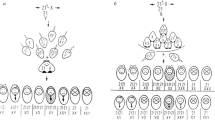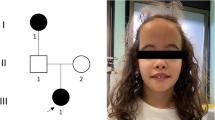Abstract
We have mapped the autosomal sex reversal locus, SRA1, associated with campomelic dysplasia (CMPD1) to 17q24.3–q25.1 by three independent apparently balanced de novo reciprocal translocations. Chromosome painting indicates that the translocated segment of 17q involves about 15% of chromosome 17 in all three translocations, corresponding to a breakpoint at the interphase between 17q24–q25. All three 17q breakpoints were localized distal to the growth hormone locus (GH), and proximal to thymidine kinase (TK1). Due to the distal location of the breakpoints, previously mentioned candidate genes, HOX2 and COL1A1, can be excluded as being involved in CMPD1/SRA1. The mouse mutant tail–short (Ts) which maps to the homologous syntenic region on mouse chromosome 11, displays some of the features of CMPD1.
This is a preview of subscription content, access via your institution
Access options
Subscribe to this journal
Receive 12 print issues and online access
$209.00 per year
only $17.42 per issue
Buy this article
- Purchase on Springer Link
- Instant access to full article PDF
Prices may be subject to local taxes which are calculated during checkout
Similar content being viewed by others
References
Berta, P. et al. Genetic evidence equating SRY and the testis-determining factor. Nature 348, 448–450 (1990).
Jäger, R.J. et al. A human XY female with a frame shift mutation in the candidate testis-determining gene SRY. Nature 348, 452–454 (1990).
Sinclair, A.H. et al. A gene from the human sex-determining region encodes a protein with homology to a conserved DNA-binding motif. Nature 346, 240–244 (1990).
Gubbay, J. et al. A gene mapping to the sex-determining region of the mouse Y chromosome is a member of a novel family of embryonically expressed genes. Nature 346, 245–250 (1990).
Koopman, P., Münsterberg, A., Capel, B., Vivian, N. & Lovell-Badge, R. Expression of a candidate sex-determining gene during mouse testis differentiation. Nature 348, 450–452 (1990).
Simpson, J.L., Blagowidow, N. & Martin, A.O. XY gonadal dysgenesis: genetic heterogeneity based upon clinical observations, H-Y antigen status and segregation analysis. Hum. Genet. 58, 91–97 (1981).
Houston, C.S. et al. The campomelic syndrome: review, report of 17 cases, and followup on the currently 17-year-old boy first reported by Maroteaux et al. in 1971. Am. J. med. Genet. 15, 3–28 (1983).
Ebensperger, C. et al. No evidence of mutations in four candidate genes for male sex determination/differentiation in sex-reversed XY females with campomelic dysplasia. Ann. Génét. 34, 233–238 (1991).
Maraia, R., Saal, H.M. & Wangsa, D. A chromosome 17q de novo paracentric inversion in a patient with campomelic dysplasia; case report and etiologic hypothesis. Clin. Genet. 39, 401–408 (1991).
Young, I.D., Zuccollo, J.M., Maltby, E.L. & Broderick, N.J. Campomelic dysplasia associated with a de novo 2q;17q reciprocal translocation. J. med. Genet. 29, 251–252 (1992).
Cooke, C.T. et al. Campomelic dysplasia with sex reversal: morphological and cytogenetic studies of a case. Pathology 17, 526–529 (1985).
Engel, W., Reinwein, H., Bombel, D., Ritter, H. & Wolf, U. Multiple Missbildungen bei einem Mädchen mit dem Karyotypus 46,XY,17q+. Humangenetik 6, 311–325 (1968).
Reinwein, H. & Wolf, U. Radiological examinations of patients with autosomal aberrations. Ann. Radiol. 10, 311–316 (1967).
Lindgren, F. & Ringertz, H. Campomelic syndrome without “Campomelia”. Ann. Radiol. 23, 168 (1980).
Bricarelli, F.D. et al. Sex-reversed XY females with campomelic dysplasia are H-Y negative. Hum. Genet. 57, 15–22 (1981).
Friedrich, U., Schaefer, E. & Meinecke, P. Campomelic dysplasia without overt campomelia. Clin. Dysmorphol. 1, 172–178 (1992).
MacPherson, R.I., Skinner, S.A. & Donnenfeld, A.E. Acampomelic campomelic dysplasia. Pediatr. Radiol. 20, 90–93 (1989).
Sørensen, P.D., Lomholt, B. & Frederiksen, B., Tommerup, N. Fine mapping of human 5S rRNA genes to chromosome region 1q42.11–42.13. Cytogenet. cell Genet. 57, 26–9 (1991).
ISCN: An International System for Human Cytogenetic Nomenclature (eds Harnden, D.G. & Klinger, H.P.). 1–117 (Karger, Basel, 1985).
Carter, N.P. et al. Reverse chromosome painting: a method for the rapid analysis of aberrant chromosomes in clinical analysis. J. med. Genet. 29, 299–307 (1992).
Polymeropoulos, M.H., Rath, D.S., Xiao, H. & Merril, C.R. A simple sequence repeat polymorphism at the human growth hormone locus. Nucl. Acids Res. 19, 689 (1991).
Solomon, E. & Ledbetter, D.H. Report of the committee on the genetic constitution of chromosome 17. Cytogenet. cell Genet. 58, 686–738 (1991).
Fain, P.R. Third international workshop on human chromosome 17 mapping. Cytogenet. cell Genet. 60, 177–186 (1992).
Bridge, J. et al. Partial deletion of distal 17q. Am. J. med. Genet. 21, 225–229 (1985).
Giannotti, A. et al. Partial deletion of the long arm of chromosome 17. Clinical case. Minerva Pediatr. 44, 51–54 (1992).
Luke, S., Bennett, H.S., Pitter, J.H. & Verma, R.S. A new case of monosomy for 17q25–qter due to a maternal translocation [t(3; 17)(p12;q24)]. Ann Génét. 35, 48–50 (1992).
Schimke, R.N. XY sex-reversed campomelia — possible an X-linked disorder? Clin. Genet. 16, 62–63 (1979).
McKusick, V.A., Inheritance in Man. 10th edn 1262–1263 (Johns Hopkins University Press, Baltimore, 1992).
Kuwano, A. et al. Detection of deletions and cryptic translocations in Miller-Dieker syndrome by in situ hybridization. Am. J. hum. Genet. 49, 707–714 (1991).
Frezal, J. & Schinzel, A. Report of the committee on clinical disorders and chromosomal deletion syndromes (Human Gene Mapping 11). Cytogenet. cell Genet. 58, 986–1052 (1991).
Lenzini, E. et al. Partial duplication of 17 long arm. Ann. Genet. 31, 175–180 (1988).
Schmickel, R.D. Contiguous gene syndromes: a component of recognizable syndromes. J. Pediatr. 109, 231–241 (1986).
Chandley, A.C. On the parental origin of de novo mutation in man. J. med. Genet. 28, 217–23 (1991).
Buchberg, A.M., Buckwalter, M.S. & Camper, S.A. Mouse chromosome 11. Mamm. Genome 3, S162–S181 (1992).
Morgan, W.C. A new tail-short mutation in the mouse. J. Hered. 41, 208–215 (1950).
Deol, M.S. Genetical studies on the skeleton of the mouse. XXVIII. Tail-short. Proc. R. Soc. Lond. 155, 78–95 (1961).
Collins, F.S. Positional cloning: Let's not call it reverse anymore. Nature Genet. 1, 3–6 (1992).
Fannemel, M., Riise, R., Lofterød, B. & Tommerup, N. High-resolution chromosome analysis in autosomal recessive disorders. Laurence-Moon-Bardet-Biedl syndrome. Clin. Genet. 43, 111–112 (1993).
Schempp, W. & Meer, B. Cytologic evidence for three human X-chromosomal segments escaping inactivation. Hum. Genet. 63, 171–174 (1983).
Lichter, P. et al. Fluorescence in situ hybridization with Alu and L1 polymerase chain reaction probes for rapid characterization of human chromosomes in hybrid cell lines. Proc. natn. Acad. Sci. U.S.A. 87, 6634–6638 (1990).
Silahtaroglu, N., Türner, Z., Kristensen, T., Sottrup-Jensen, L. & Tommerup, N. Assignment of PAPPA to 9q33.1 by fluorescence in situ hybridization to mitotic and meiotic chromosomes. Cytogenet. cell Genet. 62, 214–216 (1993).
van den Engh, G.J., Trask, B., Gray, J.W., Langlois, P. & Yu, L.C. Preparation and bivariate abnalysis of suspensions of human chromosomes. Cytometry 6, 92–100 (1985).
van den Engh, G., Trask, B., Lansdorp, P. & Gray, J. Improved resolution of flow cytometric measurements of Hoechst- and chromomycin A3 stained human chromosomes after addition of citrate and sulfite. Cytometry 9, 266–270 (1988).
Williamson, R. et al. Report of the DNA committee and catalogues of cloned and mapped genes, markers formatted for PCR and DNA polymorphisms. Human Gene Mapping 11. Cytogenet. cell Genet. 58, 1190–1832 (1991).
Author information
Authors and Affiliations
Rights and permissions
About this article
Cite this article
Tommerup, N., Schempp, W., Meinecke, P. et al. Assignment of an autosomal sex reversa– locus (SRA1) and campomelic dysplasia (CMPD1) to 17q24.3–q25.1. Nat Genet 4, 170–174 (1993). https://doi.org/10.1038/ng0693-170
Received:
Accepted:
Issue Date:
DOI: https://doi.org/10.1038/ng0693-170
This article is cited by
-
Identification of five novel genetic loci related to facial morphology by genome-wide association studies
BMC Genomics (2018)
-
The clinical impact of chromosomal rearrangements with breakpoints upstream of the SOX9gene: two novel de novo balanced translocations associated with acampomelic campomelic dysplasia
BMC Medical Genetics (2013)
-
Störungen der männlichen Gonadendifferenzierung
Medizinische Genetik (2011)
-
Isolation and Expression Analysis of Testicular Type Sox9b in Allotetraploid Fish
Marine Biotechnology (2007)
-
Systematic re-examination of carriers of balanced reciprocal translocations: a strategy to search for candidate regions for common and complex diseases
European Journal of Human Genetics (2006)



